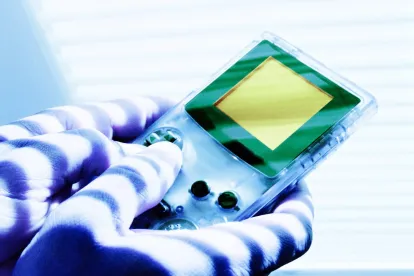Bot M8 LLC, a patent assertion entity, was unsuccessful in its effort to have the Federal Circuit reverse the lower court’s invalidity finding related to one of six different patents asserted against Sony in Northern District of California. In fact, the Federal Circuit was so unpersuaded by Bot M8’s arguments that it devoted less than a page of the 25-page opinion to this portion of the appeal. That being said, the little that was written is yet another reminder to draft and prosecute software/gaming patent applications with patent eligibility attacks in mind.
Since the court found “no need to discuss [the district court’s § 101] analysis in any detail,” and instead found claim 1 of U.S. Patent No. 7,338,363 (“the ’363 patent”) ineligible under § 101 for the reasons explained by the district court, we need to take a look at the lower court’s analysis of the purported improved gaming machine to gain insight. A quick background recap: Sony moved for summary judgment of invalidity of claim 1 of the ʼ363 patent under 35 U.S.C. § 101 after the infringement claims in the other four asserted patents were dismissed for failure to state a claim. Sony’s main argument was that claim 1 of the ’363 patent was directed to the abstract idea of “adding numbers (i.e., ‘game results’) in order to generate further numbers (i.e., ‘total result’ and ‘specification value’).”
The lower court found that the ʼ363 patent met step 1 of Alice in that it was directed to the abstract idea and failed step 2 of Alice since the court found no inventive concept. At step 1, the abstract idea was deemed to be “increasing or decreasing the risk-to-reward ratio, or more broadly the difficulty, of a multi-player game based upon previous aggregate results.” The lower court opined that “[a]t the most specific, claim 1 of the ’363 patent doesn’t actually teach how to increase or decrease the difficulty of a slot machine, or any gaming machine for that matter, based on prior results to keep players engaged.” Instead, “a game machine that updates the game conditions based on past results to keep players engaged” is merely a result, not the necessary means or process to achieve that result.
Looking at the claim itself (reproduced below for ease of reference), it might seem that, because it expressly features a gaming machine, it is a sufficiently tangible invention.
1. A first gaming machine for transmitting/receiving data to/from a server, comprising:
-
a specification value setting device for setting at least one specification value as a control condition for game control;
-
a transmitting device for transmitting data of a game result to the server;
-
a gaming machine determining device for determining a second gaming machine operated by a co-player;
-
a total result data receiving device for receiving from the server data of a total game result achieved by the first gaming machine and the second gaming machine based on the data of the game result transmitted by the transmitting device;
-
a specification value determining device for determining a specification value based on the data of the total game result received by the total result data receiving device; and
-
a specification value renewing device for renewing to replace the specification value set by the specification value setting device with the specification value determined by the specification value determining device.
However, step 1 of Alice looks to the focus of the claim and its character as a whole to determine whether a claim recites an abstract idea. Here, the tangible component (i.e., the gaming machine) merely limits the abstract idea to a particular environment. In other words, the focus of the claim was not the machine, but instead the abstract idea of increasing or decreasing the odds or difficulty of a gaming machine based upon the players’ winnings or losses. And, there is nothing in the claim that recites how the conditions of the game change based on the game results.
Moving on to step 2, the court deemed the claim elements to merely describe “generic and functional hardware” to accomplish the abstract duties. More specifically, transmitting data, determining a specification value, and replacing a specification value were considered conventional computer tasks. The court also noted that, while sometimes the order of claim elements can transform an invention into patentable subject matter, there was nothing in the order of the elements in claim 1 of the ʼ363 patent that saved it from the ineligible fate. In short, the court found that “neither the patent specification, patent owner, or patent owner’s experts articulate a technological problem solved by the ’363 patent.”
How could this claim have been written differently to be patent eligible? Perhaps the claim might have included more detail on how the game specification value increases if the players perform well and how the game specification value decreases if the players perform poorly. But, keep in mind, the specification needs to be written in a way that supports the claim language. Here, the written description was also found lacking since it only “partially illuminates the parameters to change, the payout parameters, and the driving variable, the actual prior payout.” The lower court found that the descriptions were vague and qualitative and failed to provide any teaching of threshold values that trigger changed game parameters. And, let’s face it, predicting patent ineligibility attacks is difficult, especially since different jurisdictions (and even judges within the same jurisdictions) interpret § 101 differently. This highlights why careful and creative drafting from the onset and diligence during prosecution are so critical in patent applications related to software and gaming.
On a closing note, even though Bot M8 lost this battle, its war against Sony is not over. In fact, the infringement claims of two other asserted patents were revived by the Federal Circuit in this same opinion. To read more about the Federal Circuit’s view of the lower court’s demands on Bot M8 for sufficiently pleading its infringement allegations, click here.




 />i
/>i

